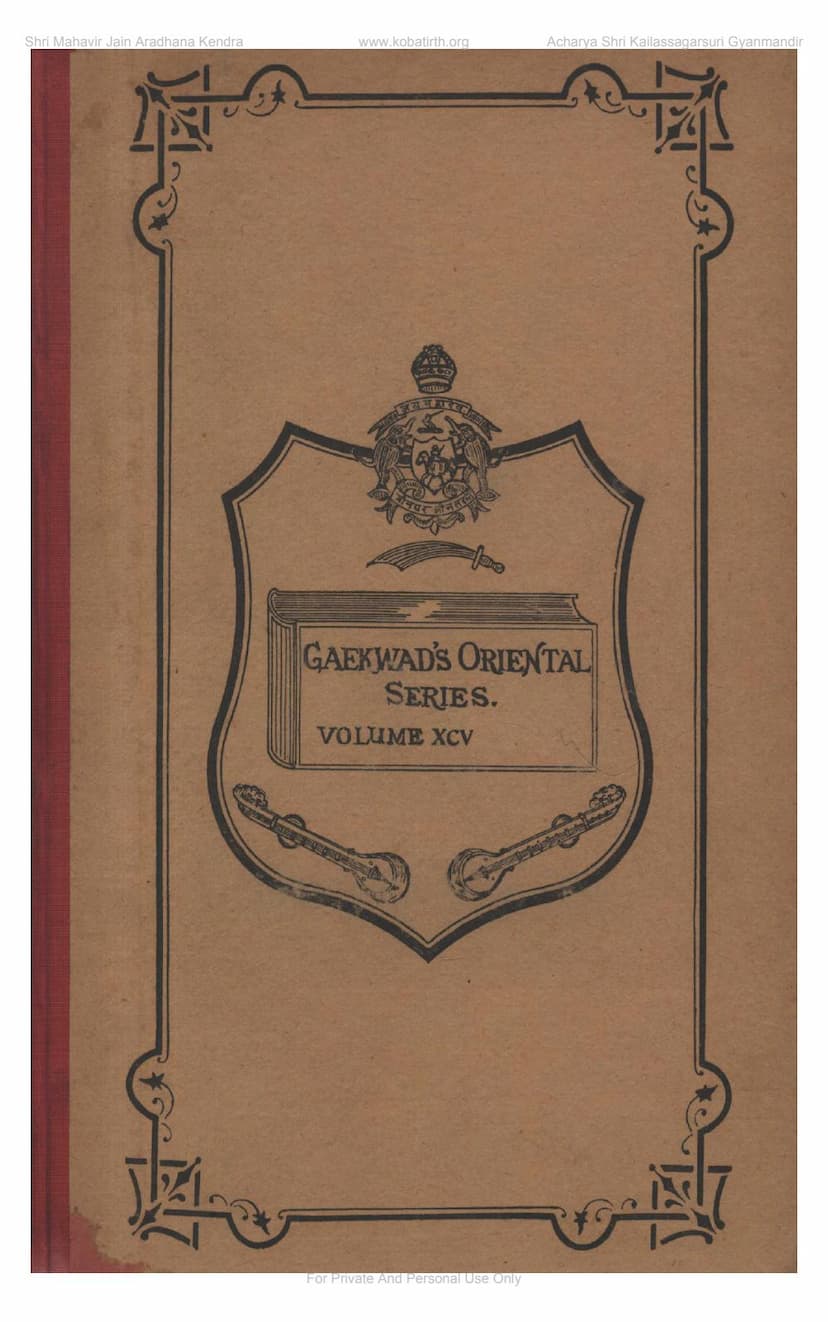Alankar Mahodadhi
Added to library: September 1, 2025

Summary
This document provides a detailed overview of the Jain text "Alankar Mahodadhi" by Narendraprabha Suri, published by the Oriental Institute in Baroda in 1942 as Volume XCV of the Gaekwad's Oriental Series. The provided pages focus on the introduction, catalog information, and the initial chapters of the work.
Here's a comprehensive summary based on the provided text:
1. Title and Author:
- Title: Alankar Mahodadhi (अलङ्कारमहोदधिः)
- Author: Narendraprabha Suri (नरेन्द्रप्रभसूरि)
- Editor/Compiler: Lalchandra Bhagwandas Gandhi (लालचन्द्र भगवदास गांधी)
- Publisher: Oriental Institute, Baroda
- Series: Gaekwad's Oriental Series, Volume XCV
- Publication Year: 1942
2. Nature of the Work:
- "Alankar Mahodadhi" is a significant work on Sanskrit poetics and literary theory (Alankara Shastra).
- It is described as an "ocean of ornaments" (Mahodadhi) for poetry, signifying its comprehensive coverage of poetic devices and principles.
- The work critically edited with an introduction in Sanskrit, indices, and appendices, indicating a scholarly approach to its presentation.
3. Context and Background:
- The publication is part of the Gaekwad's Oriental Series, which is known for publishing critical editions of Oriental literature, supported by the Government of His Highness the Maharaja Gaekwad of Baroda.
- The introduction (Prastavana) highlights the rich tradition of Jain scholarship and literary patronage in Gujarat.
- It mentions prominent Jain scholars and their contributions, such as Hemachandra Suri, and the patronage received from rulers like Siddharaja and Kumarapala, emphasizing the intellectual environment that fostered such works.
- The text traces the lineage of scholars and gurus, specifically the Harshapurīya Gachchha, to which Narendraprabha Suri belonged, providing details about his preceptors like Narachandra Suri and Abhayadeva Suri. This context underscores the scholarly tradition and expertise behind the text.
4. Content and Structure:
- The book is divided into eight "waves" (Tarangas), which are thematic sections covering various aspects of poetics:
- First Wave (Prastavana): Deals with the purpose and causes of poetry, the nature of poetic beauty (Vichitra), and the establishment of the text's foundation.
- Second Wave (Shabdavaichitrya): Focuses on the beauty and variety of words, including their different meanings (Abhidha, Lakshana, Vyanjana), the impact of grammatical forms (pratyayas), and various sound devices (Shabdalankaras like Anupras, Yamaka).
- Third Wave (Dhvani-nirnaya): Explores the concept of Dhvani (suggestion) in poetry, its different types (Vastu, Alankara, Rasa), and the role of figures of speech. It extensively discusses the nine Rasas (aesthetic emotions) and their subdivisions, along with Vibhavas (causes), Anubhavas (expressions), and Vyabhichari Bhavas (transitory emotions).
- Fourth Wave (Guneebhootavyangya): Discusses subordinate suggestion, where the suggested meaning is not the primary focus.
- Fifth Wave (Dosha-vyaavarnana): Critically examines poetic flaws (Doshas) in words and sentences, providing detailed classifications and examples.
- Sixth Wave (Guna-alankara-viveka): Differentiates between poetic excellences (Gunas) like Madhurya, Ojas, Prasada, and Alankaras (figures of speech), discussing their characteristics and classifications.
- Seventh Wave (Shabdalankara-varnana): Focuses exclusively on sound-based figures of speech like Anupras and Yamaka, detailing their various types and sub-types.
- Eighth Wave (Arthalankara-varnana): Focuses on meaning-based figures of speech (Arthalankaras), covering a vast array of devices such as Atishayokti, Sahokti, Upama, Rupaka, Utpreksha, Virodha, Asangat, Vihavana, Samasokti, Aprastuta-Prashansa, and many others. The sheer number of Alankaras discussed indicates the encyclopedic nature of the work.
5. Key Concepts Discussed:
- Poetic Purpose (Prayojana): The text aims to explore the benefits and aims of poetry, which include aesthetic delight (Ananda), attainment of Dharma, Artha, Kama, and Moksha, and the cultivation of fame and instructive wisdom.
- Causes of Poetry (Karana): It emphasizes Pratibha (poetic genius) as the primary cause, supported by Vyutpatti (learning) and Abhyasa (practice).
- Classification of Poetry: The text categorizes poetry into three types: Dhvani (suggested meaning, highest poetic quality), Guneebhootavyangya (subordinate suggestion, intermediate quality), and Avara Kavya (inferior poetry, primarily relying on literal meaning).
- Rasas and Bhavas: A significant portion is dedicated to the theory of Rasa, detailing the nine principal Rasas, their Sthayi Bhavas (dominant emotions), Vibhavas (causes), Anubhavas (expressions), and Vyabhichari Bhavas (transitory emotions).
- Alankaras (Figures of Speech): The book comprehensively discusses both Shabdalankaras (sound-based figures of speech) and Arthalankaras (meaning-based figures of speech), providing definitions, classifications, and numerous examples from classical Sanskrit literature.
- Gunas (Poetic Excellences) and Doshas (Poetic Flaws): It elaborates on the qualities that enhance poetry (Gunas like Madhurya, Ojas, Prasada) and the flaws that detract from it (Doshas), offering detailed analyses.
6. Scholarly Significance:
- The text is recognized as a scholarly compilation, critically edited with introductions and indices.
- It references and analyzes the works of numerous classical Sanskrit poets and theorists, showcasing the author's deep knowledge of the subject.
- The inclusion of a detailed table of contents (Vishayanukrama) and indices of historical names and quoted verses further highlights its academic rigor.
- The publication itself, being part of the Gaekwad's Oriental Series, signifies its value and contribution to Oriental studies.
In essence, "Alankar Mahodadhi" is a comprehensive and scholarly treatise on Sanskrit poetics, offering a deep dive into the intricacies of poetic expression, figures of speech, aesthetic emotions, and literary principles, rooted in the rich tradition of Jain literature and scholarship.